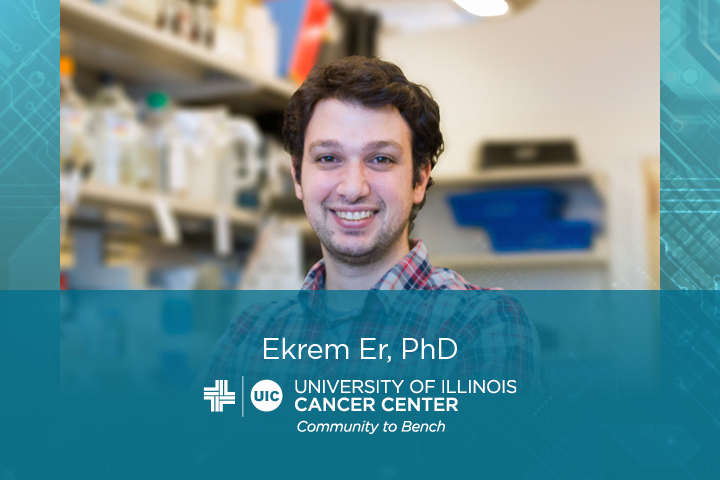
University of Illinois Cancer Center member Ekrem Emrah Er has never considered himself a star, but the American Association of Cancer Research does.
The AACR named Er, PhD, assistant professor of physiology and biophysics at the University of Illinois College of Medicine and a member of the Cancer Center’s Cancer Biology program, a NextGen Star at the organization’s annual meeting held in New Orleans. According to the AACR, the NextGen Stars program “provides an exciting opportunity to increase the visibility of early-career scientists and to support the professional development and advancement of those selected.”
When Er was informed of his selection, he was in disbelief.
“The American Association for Cancer Research is an outstanding organization with more than 50,000 members worldwide. Within such a vast organization, I am incredibly honored to be named one of the 14 NextGen Stars,” he said. “I was very happy to represent the University of Illinois Cancer Center at this heavily attended symposium and thrilled to witness the excitement that surrounded my novel field of research.”
During the organization’s symposium, Er presented his work, “Elevated cellular stiffness sensitizes metastatic cells to destruction by mechanosurveillance: The mechanical mode of immune surveillance” during a panel on extracellular matrix remodeling in cancer. He appeared alongside prominent cancer researchers Valerie Weaver, University of California San Francisco; Richard Hynes, Massachusetts Institute of Technology; and Mara Sherman from Oregon Health Sciences University.
Er’s laboratory focuses on understanding how mechanochemical signal transduction (mechanotransduction) within the tumor microenvironment impacts the interactions between cancer cells, vascular stromal cells and immunity during the outgrowth of lethal metastases. His AACR presentation detailed his recent findings that increasing the stiffness of disseminated cancer cells sensitizes them to destruction by cytotoxic lymphocytes, specifically through myocardin-related transcription factor (MRTFA/B) activity.
“Tumor evolution is coupled to profound biophysical changes in cancer cells, and understanding how these changes impact metastasis can reveal novel therapeutic targets,” Er said. “One prominent biophysical characteristic of cancer cells is their stiffness. At the early stages of the metastatic cascade, transformed cells become physically softer, allowing them to invade into and to navigate through the surrounding extracellular matrix.
“Conversely, cancer cells that later circulate need to maintain a higher degree of biophysical stiffness in order to withstand shear forces that otherwise cause mechanical rupture of cancer cells during hematogenous dissemination. However, the impact of the cellular stiffness on the final stage of metastatic colonization in vital secondary organs is not well understood.”
Er’s lab utilized a series of novel biophysical approaches to measure the stiffness of metastatic foci in situ in his most recent work, which demonstrated that physically stiffer metastatic foci are eliminated by the immune surveillance. During his experiments, bioinformatics was used to analyze patient data and loss-of-function and gain-of-function to identify therapeutically actionable proteins that increase cancer cell stiffness. Er’s findings revealed pharmacological manipulations that increase cancer cell stiffness that could provide a road map for promoting mechanosurveillance in metastatic niches.
